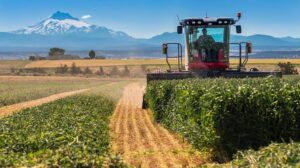National Agriculture Day is held March 24th this year, with a weeklong celebration March 22-28. Official events typically held in Washington D.C. have been cancelled, however ag education can, and should, be an everyday event.

Ag Literacy
The purpose of National Ag Day and Week to is educate and celebrate the benefits of agriculture in our nation and local communities. The National Ag Day program is committed to educating the public about how our food, renewable resource products, and clothing materials are grown and produced.
Do you know where your food is grown or raised?
The average farmer feeds approximately 144 people worldwide according the U.S. Department of Agriculture (USDA).
Contrary to common misconceptions, farmers do more than raise corn in Iowa. A farmer may grow Christmas trees in the Pacific Northwest. Or harvest cranberries in Wisconsin. The milk used in your morning cereal was produced by a farmer. Additionally, the grains used in the cereal came from farmers right here at home.
The purpose of National Ag Day and Week to is educate and celebrate the benefits of agriculture in our nation and local communities.
American grown agriculture products are vital to our economy. According to the USDA, agriculture is the #1 export of the United States. Moreover informed Americans are able to shape and support agricultural bills that allow the industry to remain competitive. In 2017, agriculture, and its related industries, contributed $1.053 trillion to the U.S. gross domestic product.
Georgia Agriculture
Agriculture contributes to 22 million jobs in the U.S. Nearly 400,000 of those jobs are related to food and fiber production right here in Georgia.
Peaches are synonymous with Georgia. Yet, surprisingly, peaches don’t even make the Top 10 of Georgia commodities by value. Georgia raises more broiler chickens than other state. Much thanks to Eli Whitney and the invention of the cotton gin for allowing Georgians to plant over 1 million acres of the American’s favorite clothing material, cotton.
Top 10 Georgia Commodities by Value (2020 Ag Snapshot)
- Broiler Chickens
- Eggs
- Cotton
- Beef
- Timber
- Peanuts
- Greenhouse
- Dairy
- Blueberries
- Corn
Share the Road
As spring rolls around, expect to see more tractors and farm equipment on the road. Therefore, practice safe driving and share the road.
Note: Never operate farm machinery without proper safety training. It is also inadvisable to ride along in or on tractors, planters, combines, and other pieces of farm equipment.
Drive defensively
During planting (spring) and harvest (fall) season, expect to see farm equipment on rural roads. Anticipate that farm vehicles will enter the highway from unmarked locations.
Slow down
Tractors are built for precision, not speed. Be patient. Maintain of safe distance of 50 feet behind farm vehicles.
Pass carefully
Farmers don’t intentionally try to slow down other vehicles. Proceed with caution when passing a farm vehicle and adhere to the standard passing regulations.
Yield
An approaching farm tractor may be twice the width of your vehicle. Slow down and move to the shoulder, if possible, to allow the tractor to pass.
Growing America and Georgia
Be safe, smart, and supportive during National Ag Week and every week in the future. Farmers are growing America.
Contact Hines Law if you have been involved in a farm-related workplace accident or personal injury as a result of farm machinery.
